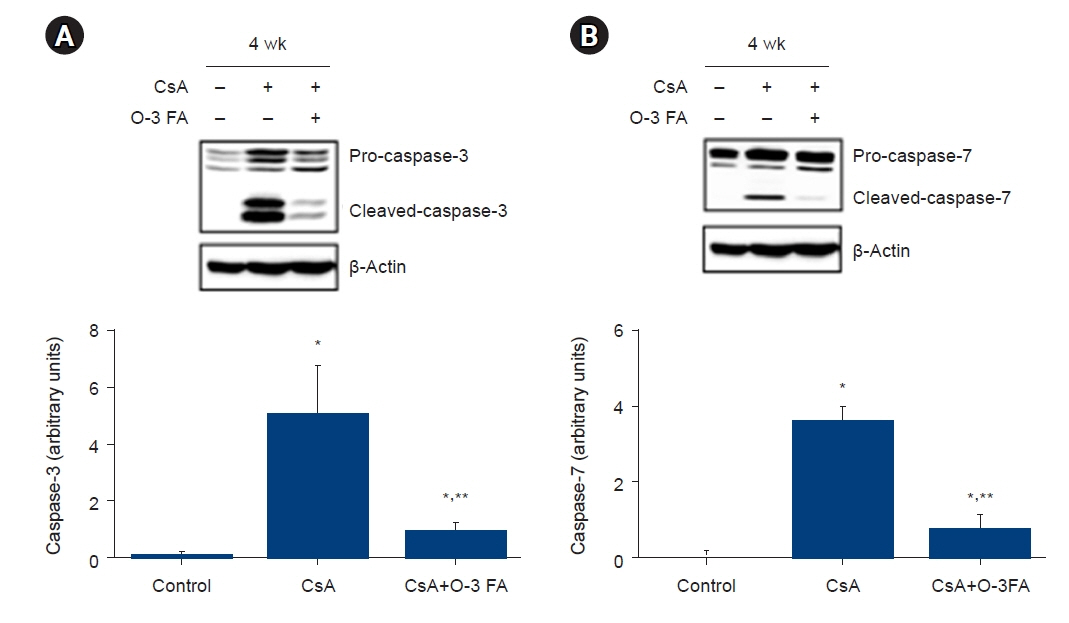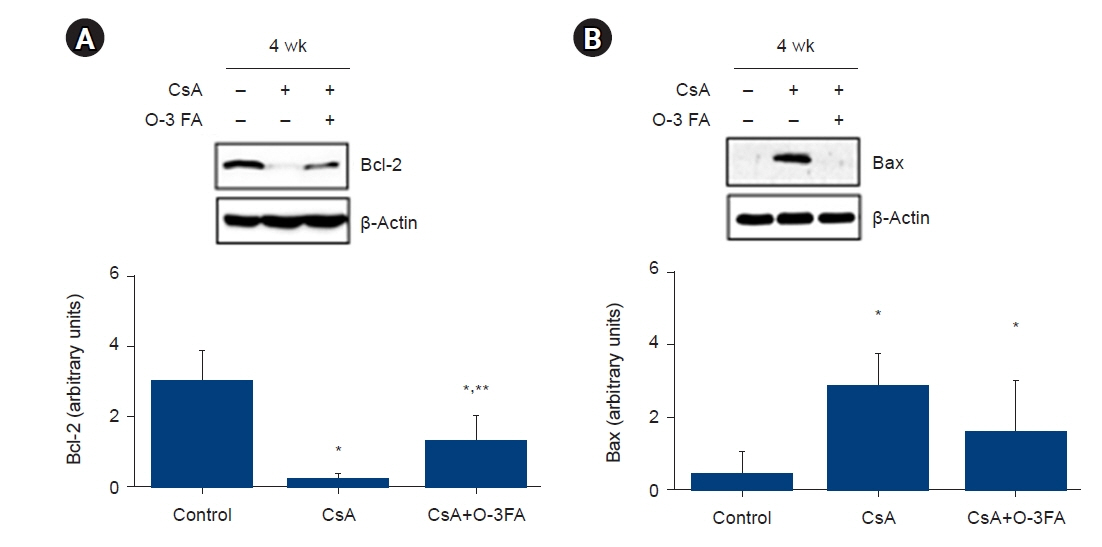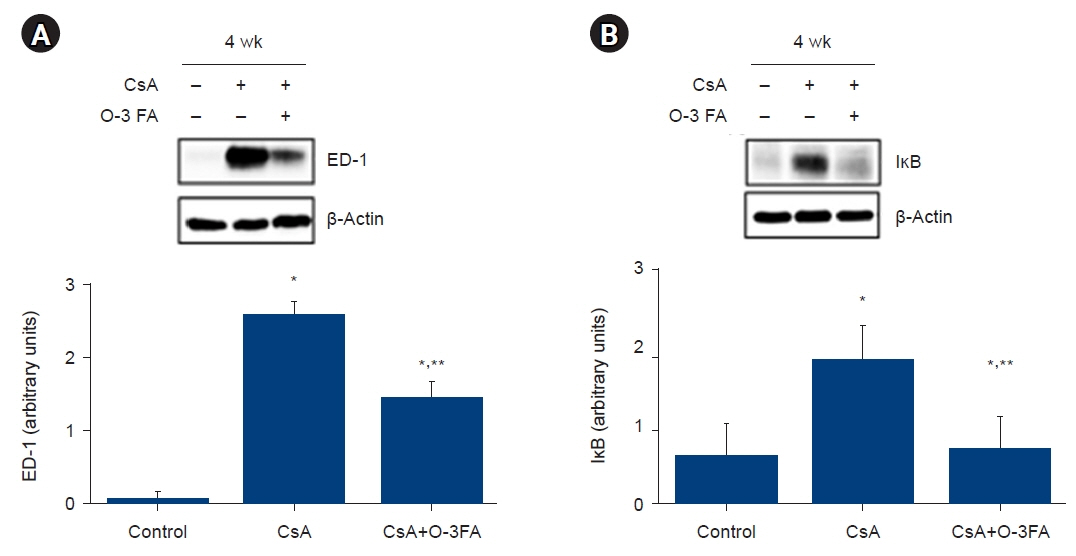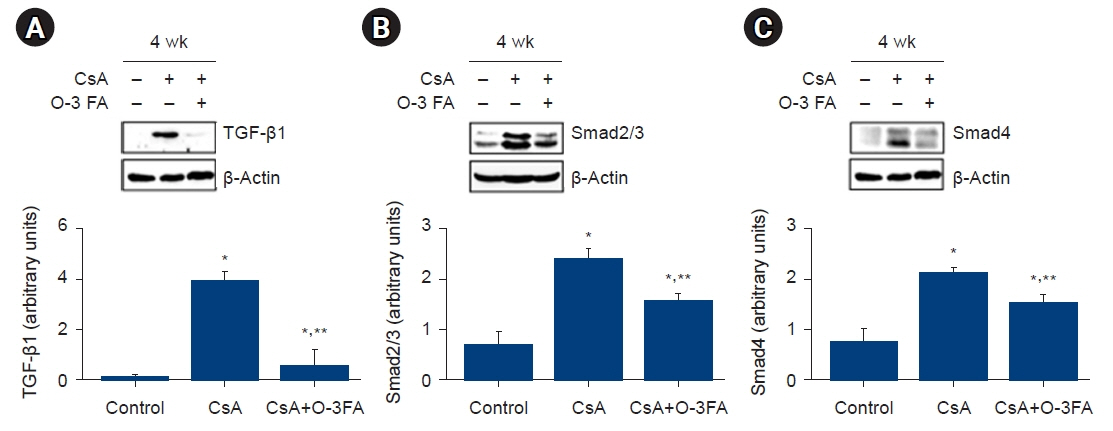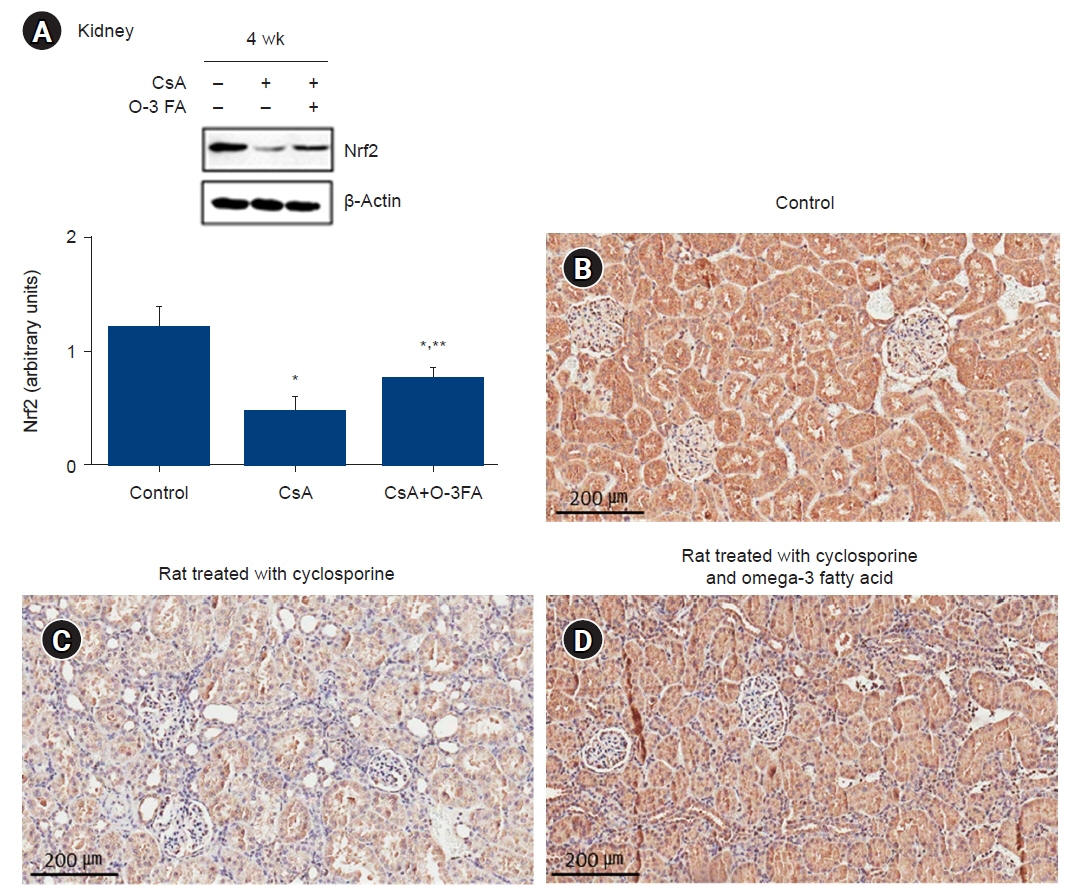Kosin Med J.
2023 Sep;38(3):184-192. 10.7180/kmj.23.112.
Omega-3 fatty acids upregulate Nrf2 expression and attenuate apoptosis, inflammation, and fibrosis in a rat model of cyclosporine-induced nephropathy
- Affiliations
-
- 1Department of Internal Medicine, Dong-A University College of Medicine, Busan, Korea
- 2Department of Anatomy and Cell Biology, Dong-A University, Busan, Korea
- 3Medical Science Research Center, Dong-A University, Busan, Korea
- KMID: 2546153
- DOI: http://doi.org/10.7180/kmj.23.112
Abstract
- Background
Cyclosporine A (CsA)-induced kidney injury is characterized by renal impairment with inflammatory cell infiltrations, apoptosis, fibrosis, and hypoxic injury. It is not clear whether omega-3 fatty acids (O-3 FAs), which have anti-inflammatory and antioxidant roles, affect nuclear factor erythroid 2-related factor 2 (Nrf2) expression. The aim of this study was to investigate whether O-3 FAs affect Nrf2 expression and exert anti-inflammatory, anti-apoptotic, and anti-fibrotic effects in CsA-induced nephropathy.
Methods
Male Sprague-Dawley rats were divided into control, CsA-treated, and CsA-treated with O-3 FA groups. Nrf2 expression was measured by Western blots and immunohistochemical staining.
Results
Kidney function was impaired in the CsA-treated rats compared to the controls. Caspase-3 and caspase-7 were activated in the CsA-treated group, and the Bax/Bcl2 ratio was higher. O-3 FAs attenuated these apoptosis-related changes. ED-1 and inhibition of kappa B (IĸB) protein expression were significantly upregulated in the CsA-treated group. Compared to the control group, O-3 FA supplementation attenuated the increased expression of ED-1 and IĸB related to inflammation. Smad2/3, Smad4, and transforming growth factor-β1 were activated in the CsA group, and O-3 FA treatment prevented these changes related to renal fibrosis. The expression of Nrf2 was reduced in CsA-treated rats, but Nrf-2 was increased by O-3 FA treatment.
Conclusions
We suggest that Nrf2 is a potential mediator induced by O-3 FA supplementation and that it attenuates pro-inflammatory pathways, fibrotic processes, and apoptosis. Further studies are needed to elucidate the crosstalk between Nrf2 expression and signals related to O-3 FA treatment.
Keyword
Figure
Cited by 1 articles
-
Omega-3 fatty acids: promising therapeutic agents for combating kidney injuries
Hee-Jae Cha
Kosin Med J. 2023;38(3):157-158. doi: 10.7180/kmj.23.135.
Reference
-
References
1. Tedesco D, Haragsim L. Cyclosporine: a review. J Transplant. 2012; 2012:230386.
Article2. Capasso G, Di Gennaro CI, Della Ragione F, Manna C, Ciarcia R, Florio S, et al. In vivo effect of the natural antioxidant hydroxytyrosol on cyclosporine nephrotoxicity in rats. Nephrol Dial Transplant. 2008; 23:1186–95.
Article3. Lim SW, Hyoung BJ, Piao SG, Doh KC, Chung BH, Yang CW. Chronic cyclosporine nephropathy is characterized by excessive autophagosome formation and decreased autophagic clearance. Transplantation. 2012; 94:218–25.
Article4. Shelton LM, Park BK, Copple IM. Role of Nrf2 in protection against acute kidney injury. Kidney Int. 2013; 84:1090–5.
Article5. Jeong HS, Ryoo IG, Kwak MK. Regulation of the expression of renal drug transporters in KEAP1-knockdown human tubular cells. Toxicol In Vitro. 2015; 29:884–92.
Article6. Liu M, Grigoryev DN, Crow MT, Haas M, Yamamoto M, Reddy SP, et al. Transcription factor Nrf2 is protective during ischemic and nephrotoxic acute kidney injury in mice. Kidney Int. 2009; 76:277–85.
Article7. Hur W, Gray NS. Small molecule modulators of antioxidant response pathway. Curr Opin Chem Biol. 2011; 15:162–73.
Article8. Kensler TW, Wakabayashi N. Nrf2: friend or foe for chemoprevention? Carcinogenesis. 2010; 31:90–9.
Article9. Magesh S, Chen Y, Hu L. Small molecule modulators of Keap1-Nrf2-ARE pathway as potential preventive and therapeutic agents. Med Res Rev. 2012; 32:687–726.
Article10. Copple IM. The Keap1-Nrf2 cell defense pathway: a promising therapeutic target? Adv Pharmacol. 2012; 63:43–79.11. Eslick GD, Howe PR, Smith C, Priest R, Bensoussan A. Benefits of fish oil supplementation in hyperlipidemia: a systematic review and meta-analysis. Int J Cardiol. 2009; 136:4–16.
Article12. Thies F, Garry JM, Yaqoob P, Rerkasem K, Williams J, Shearman CP, et al. Association of n-3 polyunsaturated fatty acids with stability of atherosclerotic plaques: a randomised controlled trial. Lancet. 2003; 361:477–85.
Article13. Cawood AL, Ding R, Napper FL, Young RH, Williams JA, Ward MJ, et al. Eicosapentaenoic acid (EPA) from highly concentrated n-3 fatty acid ethyl esters is incorporated into advanced atherosclerotic plaques and higher plaque EPA is associated with decreased plaque inflammation and increased stability. Atherosclerosis. 2010; 212:252–9.
Article14. Yokoyama M, Origasa H, Matsuzaki M, Matsuzawa Y, Saito Y, Ishikawa Y, et al. Effects of eicosapentaenoic acid on major coronary events in hypercholesterolaemic patients (JELIS): a randomised open-label, blinded endpoint analysis. Lancet. 2007; 369:1090–8.
Article15. Wen YT, Dai JH, Gao Q. Effects of omega-3 fatty acid on major cardiovascular events and mortality in patients with coronary heart disease: a meta-analysis of randomized controlled trials. Nutr Metab Cardiovasc Dis. 2014; 24:470–5.
Article16. van der Heide JJ, Bilo HJ, Donker JM, Wilmink JM, Tegzess AM. Effect of dietary fish oil on renal function and rejection in cyclosporine-treated recipients of renal transplants. N Engl J Med. 1993; 329:769–73.
Article17. Sakai C, Ishida M, Ohba H, Yamashita H, Uchida H, Yoshizumi M, et al. Fish oil omega-3 polyunsaturated fatty acids attenuate oxidative stress-induced NA damage in vascular endothelial cells. PLoS One. 2017; 12:e0187934.18. Shin DH, Park HM, Jung KA, Choi HG, Kim JA, Kim DD, et al. The NRF2-heme oxygenase-1 system modulates cyclosporin A-induced epithelial-mesenchymal transition and renal fibrosis. Free Radic Biol Med. 2010; 48:1051–63.
Article19. Ishikado A, Morino K, Nishio Y, Nakagawa F, Mukose A, Sono Y, et al. 4-Hydroxy hexenal derived from docosahexaenoic acid protects endothelial cells via Nrf2 activation. PLoS One. 2013; 8:e69415.
Article20. Kusunoki C, Yang L, Yoshizaki T, Nakagawa F, Ishikado A, Kondo M, et al. Omega-3 polyunsaturated fatty acid has an anti-oxidant effect via the Nrf-2/HO-1 pathway in 3T3-L1 adipocytes. Biochem Biophys Res Commun. 2013; 430:225–30.
Article21. Yang CW, Ahn HJ, Kim WY, Li C, Jung JY, Yoon SA, et al. Synergistic effects of mycophenolate mofetil and losartan in a model of chronic cyclosporine nephropathy. Transplantation. 2003; 75:309–15.
Article22. An WS, Kim HJ, Cho KH, Vaziri ND. Omega-3 fatty acid supplementation attenuates oxidative stress, inflammation, and tubulointerstitial fibrosis in the remnant kidney. Am J Physiol Renal Physiol. 2009; 297:F895–903.
Article23. Pergola PE, Raskin P, Toto RD, Meyer CJ, Huff JW, Grossman EB, et al. Bardoxolone methyl and kidney function in CKD with type 2 diabetes. N Engl J Med. 2011; 365:327–36.
Article24. de Zeeuw D, Akizawa T, Audhya P, Bakris GL, Chin M, Christ-Schmidt H, et al. Bardoxolone methyl in type 2 diabetes and stage 4 chronic kidney disease. N Engl J Med. 2013; 369:2492–503.
Article25. Kong W, Fu J, Liu N, Jiao C, Guo G, Luan J, et al. Nrf2 deficiency promotes the progression from acute tubular damage to chronic renal fibrosis following unilateral ureteral obstruction. Nephrol Dial Transplant. 2018; 33:771–83.
Article26. Hasnan J, Yusof MI, Damitri TD, Faridah AR, Adenan AS, Norbaini TH. Relationship between apoptotic markers (Bax and Bcl-2) and biochemical markers in type 2 diabetes mellitus. Singapore Med J. 2010; 51:50–5.27. Oltvai ZN, Milliman CL, Korsmeyer SJ. Bcl-2 heterodimerizes in vivo with a conserved homolog, Bax, that accelerates programmed cell death. Cell. 1993; 74:609–19.28. Zhang L, Xu C, Hu W, Wu P, Qin C, Zhang J. Anti-inflammatory effects of Lefty-1 in renal tubulointerstitial inflammation via regulation of the NF-κB pathway. Int J Mol Med. 2018; 41:1293–304.
Article29. Eddy AA. Protein restriction reduces transforming growth factor-beta and interstitial fibrosis in nephrotic syndrome. Am J Physiol. 1994; 266(6 Pt 2):F884–93.
Article30. Nam HK, Lee SJ, Kim MH, Rho JH, Son YK, Lee SM, et al. Rosuvastatin attenuates inflammation, apoptosis and fibrosis in a rat model of cyclosporine-induced nephropathy. Am J Nephrol. 2013; 37:7–15.
Article
- Full Text Links
- Actions
-
Cited
- CITED
-
- Close
- Share
- Similar articles
-
- Letter to the Editor: Effects of Omega-3 Fatty Acids on Erectile Dysfunction in a Rat Model of Atherosclerosis-induced Chronic Pelvic Ischemia
- Omega-3 Index as a Risk Factor for Cardiovascular Disease and Its Application to Korean Population
- Polyunsaturated Fatty Acids in Children
- Effects of Omega-3 Fatty Acids on Erectile Dysfunction in a Rat Model of Atherosclerosis-induced Chronic Pelvic Ischemia
- Omega-3 polyunsaturated fatty acid and ursodeoxycholic acid have an additive effect in attenuating diet-induced nonalcoholic steatohepatitis in mice


